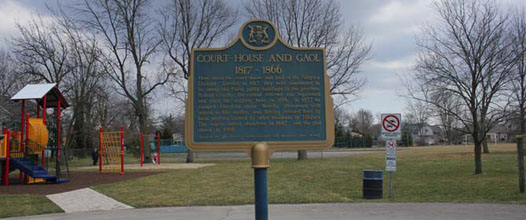Home | Places to Explore | Towns & Cities
Exploring Niagara-on-the-Lake
Maria Rye and the Orphan Immigrants
As slavery in Upper Canada was slowly phased out, a void began to develop for cheap farm labour, and a very dark, draconian method for providing this labour came about in the form of immigrant children.
In the mid 1800's many in Britain felt that the streets were becoming over-run with orphaned and abandoned children. As a means of solving this problem four women, set up an orphanage in London and Liverpool with the intent of shipping surplus children to a "new, brighter, future in Canada". One of these women, Maria Rye set up a home in Niagara-on-the-Lake, known as "Our Western Home".
The Western Home they were referring to was actually the old gaol, which was sold to Maria Rye in 1866 when the new court house was built. The gaol was then refurbished to accommodate not prisoners, but children. The street that led up to the orphanage is called Rye Street, after Maria Rye and the orphanage located in the old gaol.
From 1859 until the practice ceased by the early 1900's as many as 80,000 poor and orphaned British children under the age of 14 were sent to Canada, with as many as 14,000 ending up at Maria Rye's "Our Western Home" in Niagara-on-the-Lake. At the time many felt that it was in the children's best interest to be sent to Canada. Children could grow up in the fresh clean air of rural Canada and provide much needed assistance on the farms.
However, no background checks were ever made, nor any follow-ups of the children's progress. One can only be left to wonder at the possible conditions or abuse that some children were made to endure. Children were rarely adopted but rather "indentured" to a farmer. Some of the younger children would fare better, as quite often they would be taken in by a childless couple and raised as their own. Being placed until the age of 18, with strangers who mainly wanted cheap labour was more often the case with the older children. By the 1920's Canadians were beginning to question this practice of child emigration. James S. Woodsworth, a respected member of Canada's Parliament remarked to the House of Commons that: "We are bringing children into Canada in the guise of philanthropy, and turning them into cheap labourers."
Unlike the Canadian Parliament of a century earlier that outlawed slavery in Upper Canada, the Canadian Parliament of the 1920's was slow to react to the public outcry. However, with the stock market crash and the Great Depression of the 1930's it was no longer cost effective to ship British children to Canada and the practice ceased.
Today, the original jaol and court house and Maria Rye's "Western Home" are gone and the location is now home to Rye Heritage Park. A plaque marks the spot where the building once stood.

